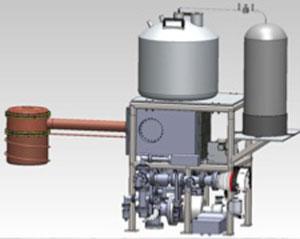
Detectors will be mounted in cryostats made from ultra-pure copper, inside a special shield, at a depth of 4850 feet below ground. Extreme measures are taken to eliminate as much background radiation as possible.
- Majorana is an experiment to search for zero-neutrino double beta (0νββ) decay in 76Ge. If observed, this decay will prove that the neutrino and the anti-neutrino are identical, and that lepton number is not a conserved quantity. It may also provide hints as to how the Big Bang produced more matter than it did antimatter, and allow us to determine the absolute mass scale of the neutrino.
- To search for this decay, Majorana uses detectors made from germanium enriched in 76Ge. In the Majorana Demonstrator experiment, two separate cryostats will each hold seven “strings” of up to 5 detectors each.
- In Feb 2014, two test strings of detectors were cooled below 80 Kelvin and operated deep underground in the MJD prototype cryostat. All detectors operated well. This is an important step in verifying the design the strings, cables, connectors, and cryostat. In May, this is being increased to three strings. Assembly of Cryostat 1 (the first ultra-pure cryostat) together with its cryogenic and vacuum systems is progressing well.
For more information contact David Radford, radforddc@ornl.gov

